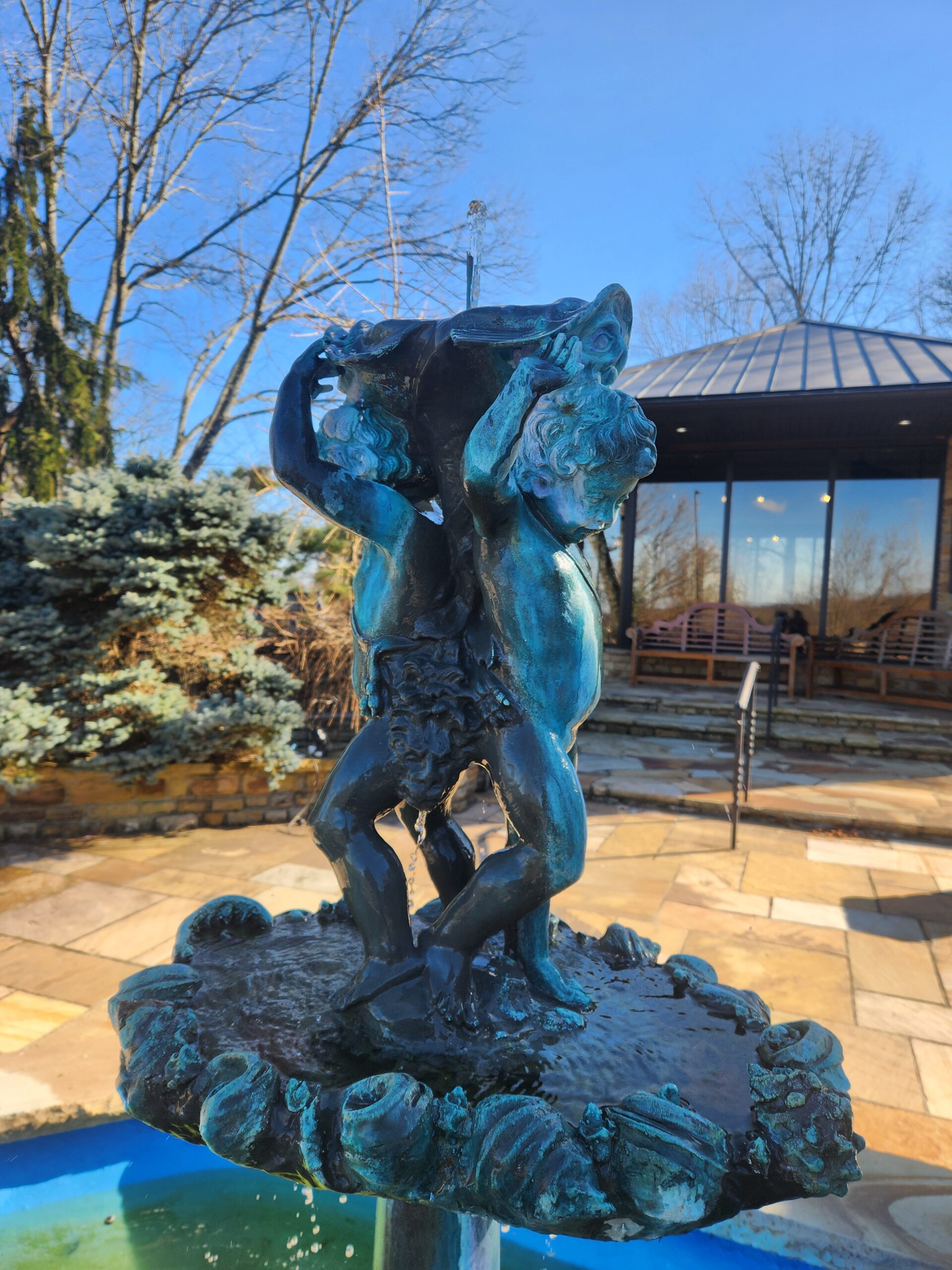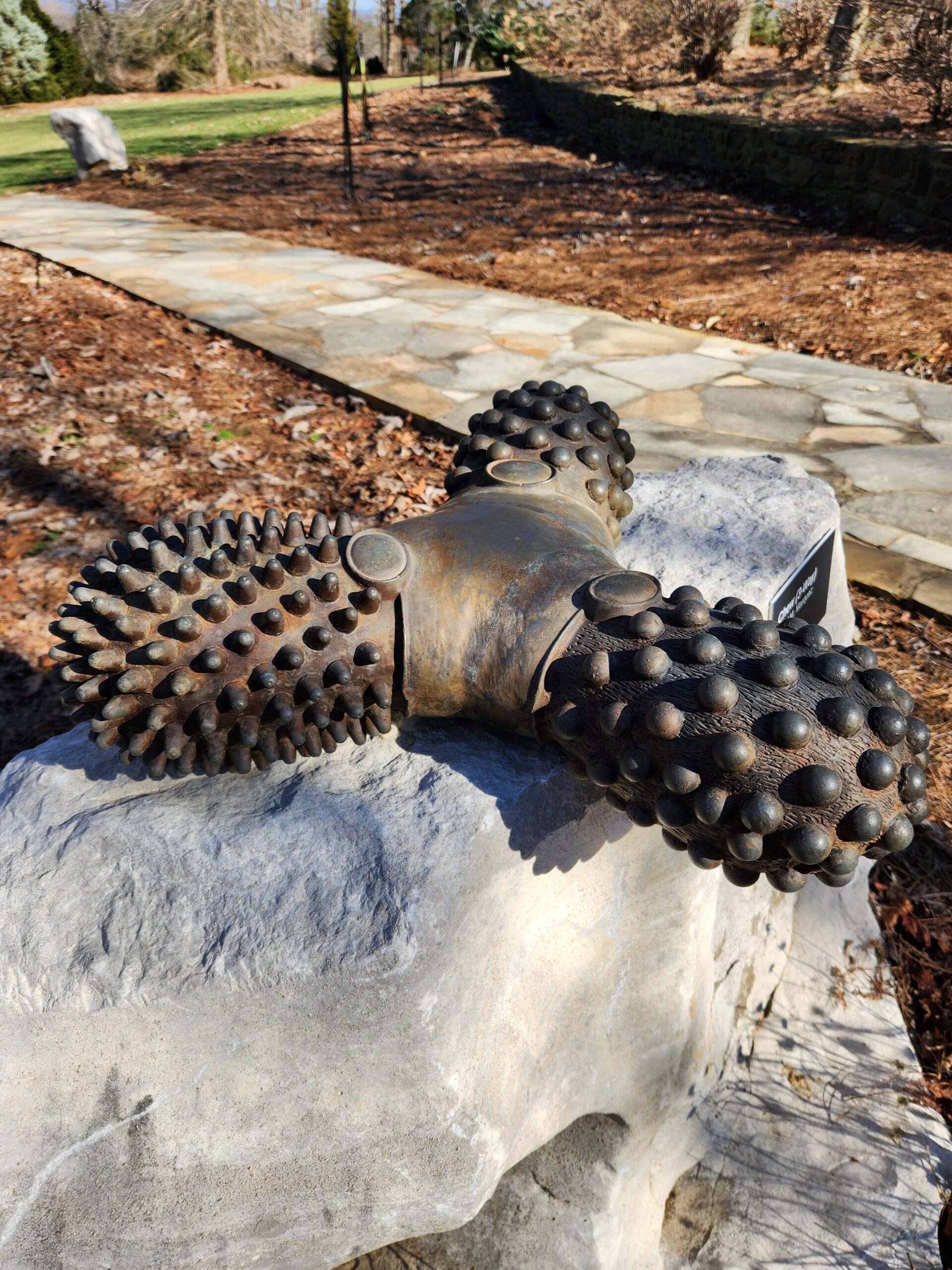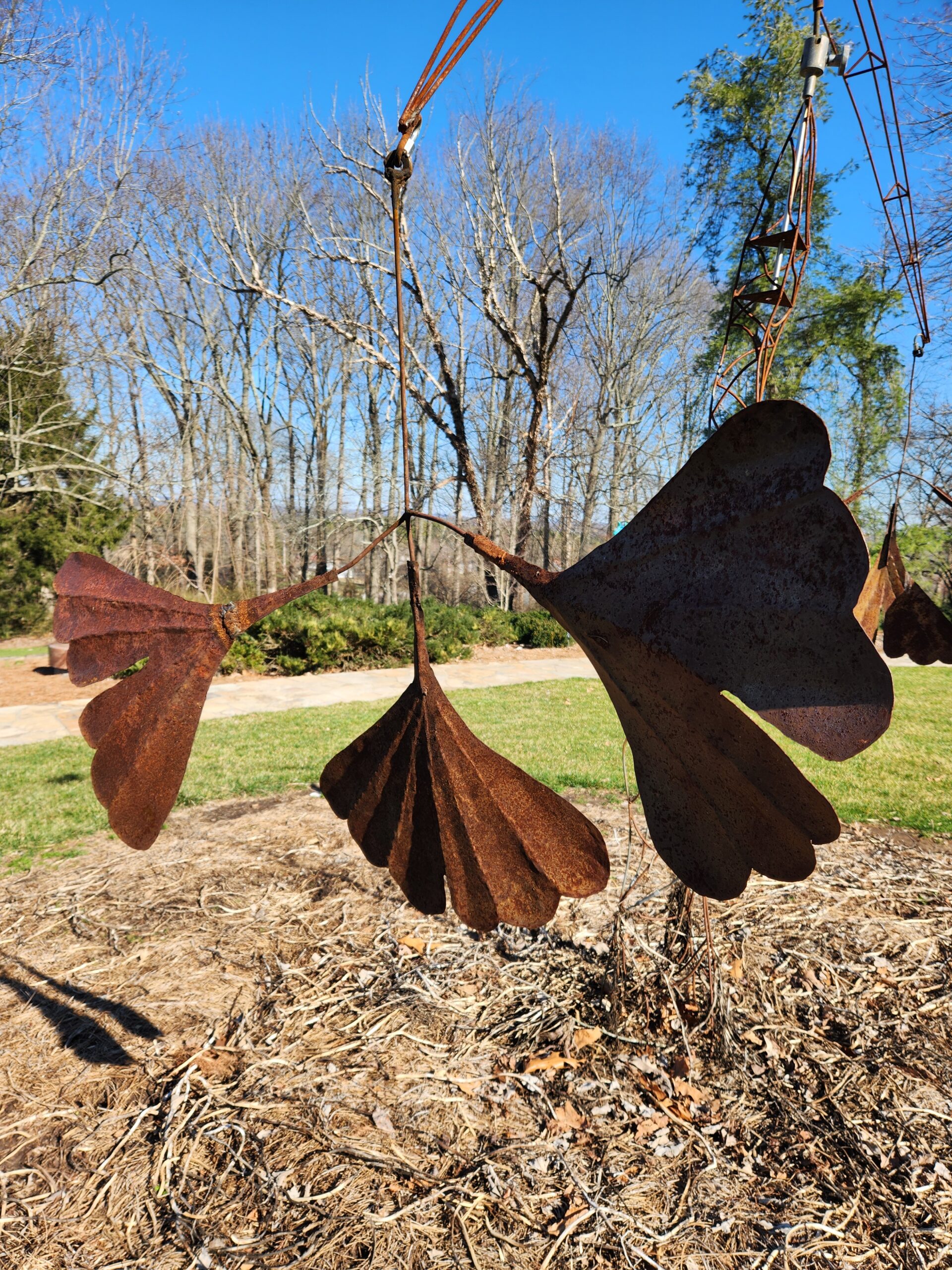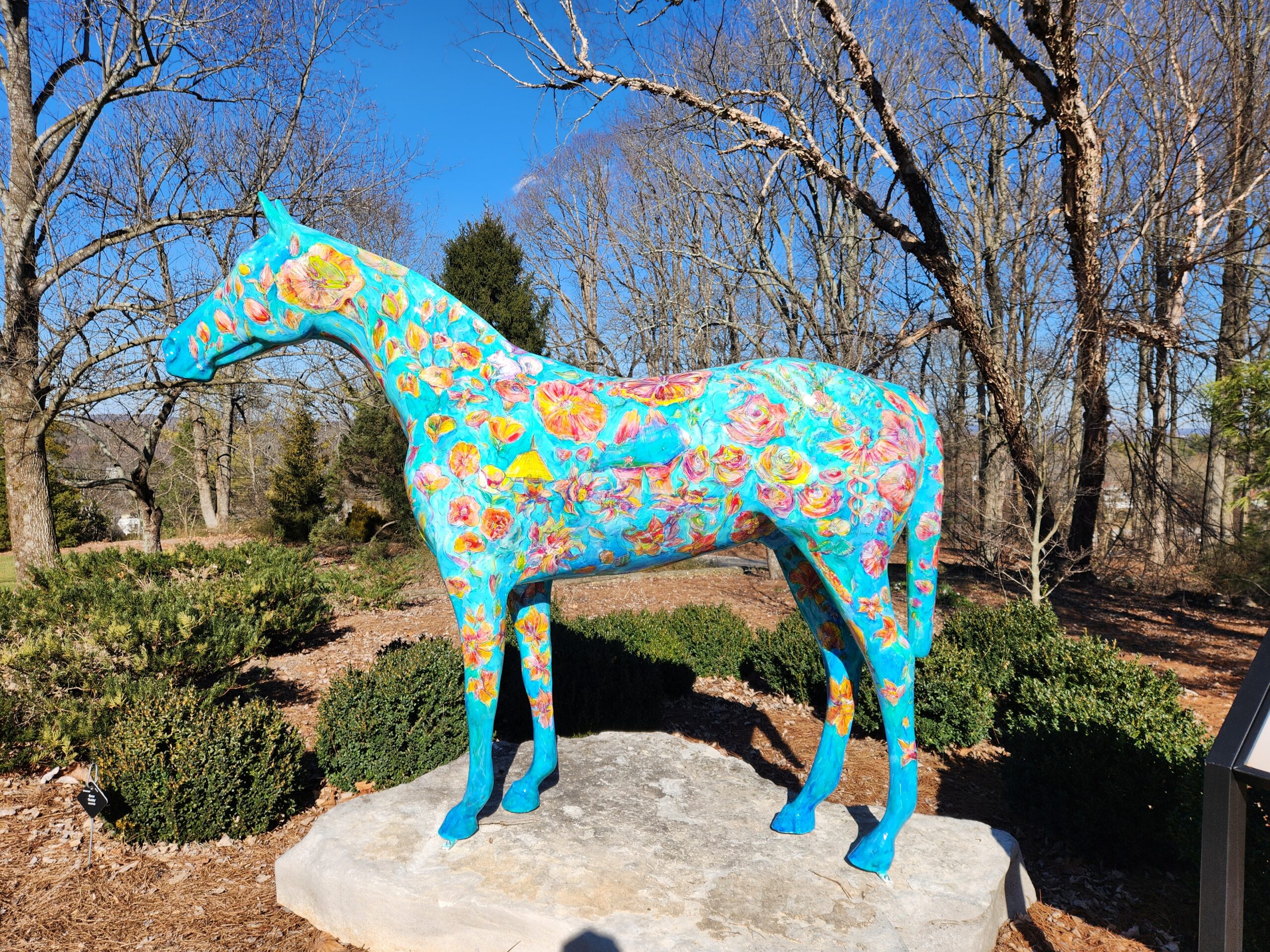
artmap

1. Untitled, 2002
Joseph Dudley Downing (1925-2007), bronze. Joe Downing carved four wooden maquettes likely sometime in the 1960s or 1970s. The bronzes, cast in 2002, is an edition of 12, and the museum owns 11 of these pieces. These pieces demonstrate Downing's ability to transpose natural beauty into art. In carving the wooden maquettes, he emphasized the constitutional elements of the trees while still adding his own style. The end result is an ethereal set of bronzes which are almost ghost-like in appearance. Their metaphysical nature gives the viewer a sense of liminality that exists somewhere between beauty and death; a place where trees transcend into phantom-like wisps of their former, worldly selves.

1. Jumping Frogs, ca. 1990s
Jan Desmarets (1961-), (Flemish), Bronze, Jan Desmarets is a Flemish sculptor. He was born in Ypres and grew up in Wervik. He studied sculpture at the Royal Academy of Fine Arts in Ghent. Master Jef Vermassen gives the following description: ``He is fascinated by the immense power, intense beauty and lean sensuality of specific animals and people, so he cannot resist using his own intensely powerful ability to express the feelings that are in his soul through his artistic creations and to truly bring them to life.`` In 2003, Jan was commissioned by the then Prime Minister of Belgium, Guy Verhofstadt as a wedding gift for Prince Laurent and Princess Claire.

2. Arm of Art
Chris Radus, chainsaw carved wood and welded metal. Created for an episode of Mainstreet filmed on location at Baker Arboretum.

3. Untitled, ca. 1990s, copper, Joseph Dudley Downing (1925-2007)
These pieces are modeled after Downing's famous ``stone poems,`` which were staple collages created in the 1960s and again in the 2000s. It is believed that Downing soldered and patinaed the pieces himself. There are 6 other examples on exhibit at the Owensboro Museum of Fine Art in Owensboro, KY.

4. Putti Fountain & other neo-classical art, ca. 1980-1990, bronze, Atillio De Luca (1930-?)
The bronze fountain features two putti-one male and one female-holding up a stylized dolphin, spurting from it's mouth a fountain of water. The male figure carries a lion pelt while the female carries a sack of fruit. The figures sit in a basin surrounded by shell motifs supported by a pedestal adorned with acanthus leaves.<br /> A putto (plural putti) is a classical figure, typically depicted as a chubby male child, sometimes with wings. The difference between putto, cherubs, Eros, cupids, and children in this style today is vague. In the ancient world, putti were winged infants that were believed to influence human lives and originally adorned Roman children sarcophagi, especially in the 2nd century. The resurgence of the putto in Renaissance art is generally attributed to Donatello in Florence in the 1420s, where we see them take on new meaning. Starting in this period, and into the current, the motif has come to represent the Greek God Eros/Roman Cupid, the Roman ``genius`` (a type of guardian spirit), or the Greek daemon (a type of messenger spirit residing between the realms of the human and the divine).<br /> The lion pelt is typically associated with Heracles (Greek-Hercules), whereas fruit is often associated with the Goddess Pomona, though no stories exist in the canon of Greco-Roman mythology connecting these two characters. The imagery, while inspired by ancient Pompeiian art, is based more on the artist's aesthetics, rather than a specific mythos, legend, or tale. The dolphin is a common motif in Greco-Roman and Neoclassical art, appearing on everything from columns to table legs, with different examples evolving through history. There are several myths of both Gods and humans interacting with and riding dolphins. To the ancient Greeks, dolphin and seashell motifs were the most notable representations of the sea. The amalgamation of these elements suggests and inspiration pointing to ancient Pompeii or another Roman seafaring culture.<br /> The De Luca family has a long history of sculptors. Attilio's grandfather, Vincenzo De Luca, co-founded the De Luca Brothers' Foundry in Naples in 1887. The foundry today is known as DelMar and is located in Capodrise, Italy and is still operated by the De Luca family. De Luca's public works are on display in Italy, New York, London, Moscow, Beijing, and Dubai, to name a few.</p> <p>Another example of neo-classical work in this area is the putto riding a sea turtle. This work is attributed to De Luca, and was probably created around the same time as the fountain.

5. Chew, ca. 2010s, bronze, David M. Marquez
``I search for meaning and understanding from the elements and systems around me. Referencing biological and botanical forms, and chemical and automated systems, my current work captures the inquisitive interests and reverence that has driven me since childhood. A primary objective is to solicit an intermission to ponder an unfamiliar familiarity. The product of these impartial and silent objects exploit notions of industrial mass production, the abstract, subtle innuendos, cellular growth, and organic propagation to allow the viewer to detect their resemblances to the human condition.`` David Marquez

5. (Un)Locked Potential, ca. 2021, cast metal, Allison Denny

6. Gingko-Go-Round, 2015, recycled metal, Chris Radus

7. In The Presence of Inflorescence, 2022, painted fiberglass, Lennon Michalski, Sam Lowe, Elma Kalabic, Alexis Shehan, & Hayli Hundley
Students Sam Lowe, Elma Kalabic, Alexis Shehan and Hayli Hundley from Warren County met virtually with artist Lennon Michalski to plan out what their collaboration would be for the design. The outline of Kentucky, with the heart representing Bowling Green, a symbol of medicine, butterflies and flowers all represent recovery and regeneration. These symbols cover every inch of the horse in a beautiful coordinating color palette. All funds raised from IN THE PRESENCE OF INFLORESCENCE will directly benefit the Family Resource Centers within both local school districts to support families in need.

8. Uruli Cookware, ca. 19th century, Malayalam (State of Kerala, India)
Uruli is a traditional cookware used extensively in the south Indian state of Kerala and neighboring regions. They were traditionally used in the home and in medicine-making, thought these larger examples would have been used to cook for large groups of people at festivals or other celebrations. In current south Asian tradition, the vessels are often used to hold flowers for the Malayalam new year celebration of Vishu Kani. The large handles would have been used to support the vessel with wooden poles for transport.

9. Millstone
Millstone

10. Seated Frog, ca. 1995, copper, Charles Smith
The big frog sculptures emerged from work to develop a model system and medium to render human-size form in direct metal sculpture. The beginning of the human-size copper frog goes back to 1974 when I, Charles Smith, started making metal sculpture (following a career in science and engineering).</p> <p>My first subjects were clowns and dancers made with sheet copper overlaid with brass, and although they were one to two feet high, there was always the desire to make them life-size in direct metal. This natural subject matter for me, coupled with the basic desire to render the life-size image of the human form in metal are the forces that led to the copper frog. Without my realizing it the clowns and dancers and jesters “morphed” into the frogs. This happened over a period of about three years during the mid-1980’s. A client on Seabrook Island for whom I had made sculpture often asked me do a frog, as he and his wife were “frog lovers” and collected various frog images and sculptures. The first frog was sitting on the ground, but was the size of a person. After several big sitting frogs, I did a number of smaller frogs, I did a number of smaller frogs obtaining a better control of the medium. Then they got bigger again, began to stand, and became involved in human activities.</p> <p>“Aliveness” is a descriptive term often used to refer to my frog sculptures. Frank Cabot (founder of The Garden Converancy) claims: “they have soul”. He has placed fifteen of the creatures at “Les Quatre Vents” Gardens at Murray Bay, near Quebec in Canada. Alston Glenn (director of Atlanta Botanical Garden, ret.) calls my work “crowd pleasers” and is responsible for seven pieces in their collection. I have made frog sculptures for public gardens and settings, schools, hospitals, and private collections all over the United States and in many foreign countries.

11. Boy Pan With Flute, late 19th century, copper and bronze, artist unknown
The bronze features a young ``Pan`` figure playing a flute while balancing on a conch shell. The figure wears Roman amulets and is adorned with grapes, flowers, and leaves on the head and lower body.<br /> Pan (Roman-Faunus) of Greco-Roman mythology served as a guardian between the civilized world and the untamed wild. His realm was Arcadia, a region in Greece revered for its rocky and hilly scenery. To the Greeks, this place was magical. It was thought to have existed before the moon and was believed to have been home to the first Greeks. Pan was through to bring about lust, uncontrollable longing, animal-like desire, and could induce an overall sense of panic, which we was known to unleash upon armies and other trespassers to his domain. In fact, the word ``panic`` comes from the Greek ``panikos,`` which is derived from the name Pan.<br /> Pan is known for his musicianship. One of his instruments was the syrinx, or pan flute. The flute was named after the nymph Syrinx, who changed herself into a cluster of reeds to escape from Pan's lustful longings. Pan then cut down the reeds and fashioned a flute out of them. Because of its easy construction and the availability of reeds, the syrinx was a common instrument in ancient Greece. Its music was said to make people dance and lower their inhibitions, becoming filled with the lustful nature of Pan.<br /> Pan as a motif has been a constant in art since the ancient times, when his worship spanned all the way from what is now Spain to the Middle East. The motif remained popular throughout the middle ages until we see a resurgence of classical antiquity in the arts and humanities during the Renaissance. This is when we see Pan morph away from the bestial God of antiquity into the wholly romanticized creature that playfully roams the bucolic wilderness that we know and admire today. This metamorphosis is seen in the Shakespearean comedy, A Midsummer Night's Dream, where the character ``Puck,`` was based on the Pan mythos. Later, the Scottish writer J.M. Barrie based his namesake character, Peter Pan, on the same mythological figure, who had, at this point in time, morphed into the young, boy Pan who possesses the magic of flight and everlasting youth. This sculpture was likely created with the same imagery of Pan in mind.<br /> The artist of this copper and bronze sculpture is unknown. It is believed to have been created in southern Italy in the late 19th century.

11. Acroterion, early 20th century, limestone
An acroterion is an architectural ornament mounted at the apex of the corner of the pediment on buildings constructed in the classical style. This particular carving showcases a variety of neo-classical motifs including a palmette (fan-shaped design on top), acanthus leaves with volutes (scroll work), as well as lotus flowers and roses. The stone carving came from a demolished building in Louisville, KY and was probably created around the turn of the late 20th century.

11. Lead Garden Eagles, 19th-20th century, cast lead
Lead garden ornaments became popular in the late 17th century, as alchemists were experimenting with turning lead into gold. They did not succeed, however, their work and research pertaining to lead, coupled with the English desire to adopt the exquisite garden styles brought about the popularity of this artform. Most garden ornaments prior to the development of lead casting were carved in stone, which is a difficult and slow process. Lead is soft, easy to melt, and lightweight. Once a mold is created, casting is readily available and can be mass-produced. Many lead ornaments during the 18th/early 19th centuries were melted down to create ammunition for the numerous wars during this period. Lead ornamentation largely fell out of style previous to the American Civil War. In the mid-to-late 19th century, lead garden ornamentation became popular again, and were mass-produced for a number of years. Examples like these would often be painted or gilded to add to their exquisite nature.

12. Stone posts with finials
Stuff

13. Frog Pond and Puddles, ca. 1995, bronze, Jo An Saylors (1932-2018)
Saylors was born in Lewisburg, TN and studied under sculptor Jo Davidson at the Watkins College of Art (now part of Belmont University). She is most known for her work depicting children, wildlife, and western-themes. Her works has been featured extensively around the United States as well as the National Museum of American Art at the Smithsonian Institute. She was also featured in several publications including Southwest Art, Southwest Profiles, and the Santa Fean.

13. Just Swimmingly, 1999, edition 5/10, David Smus
``I spend hours simply observing wildlife, and feel that I owe such beautiful creatures the dignity of proper representation.``<br /> Smus was raised in Maine where he developed and fostered a life-long love of art and the outdoors. As a young adult, he worked in preserving nature's beauty through taxidermy, gaining a thorough understanding of animal anatomy. Earning a degree in Wildlife Management from the University of Maine, he later surrendered to his artist desires and now works as an artist. A self-taught wood carver, David has worked and studied with a variety of well-known sculptors. Today, lost-wax bronze casting is his primary medium of expression. His goal is to communicate with the viewer through exquisite form, composition, and anatomy as a language that captures the bond between the natural world and mankind.

14. Rachel With Lamb at Well, ca. 1867, marble, Italian, Ferdinando Andreini (1843-1922)
Rachel was a biblical figure, married to Jacob, and was the mother of Joseph and Benhamin, two of the founders of the twelve tribes of Israel. Her name translates to ``ewe`` in Hebrew. Rachel is first mentioned in the Hebrew Bible in Genesis when Jacob first sees her as she is watering her father's flock. He falls instantly in love with her and asks her father, Laban, for her hand in marriage. Laban agrees, but requires Jacob to work for him for seven years, at which point they may marry. He is then tricked into marrying Rachel's older sister Leah, as she is veiled and he cannot see her face. Saddened to learn the truth, Laban then offers Jacob Rachel's hand in marriage if he agrees to work for him for another seven years. He does and is eventually married to Rachel, as well.<br /> Rachel is unable to conceive a child and eventually becomes jealous of Leah, who has children of her own. She offers her handmaiden, Bilhah, to Jacob and they conceive two children that Rachel takes to raise as her own. Soon after, Rachel and Jacob are finally able to conceive their son, Joseph, who was destined to become the leader of Israel's tribes between exile and nationhood.<br /> After Joseph's birth, Jacob takes his family away without telling Laban. Rachel, upset with her father for disinheriting her, steals her father's religious idols and carries them away under her saddle. After Laban follows and confronts Joseph and Rachel, she replies that she cannot get off her saddle because she is menstruating (it was forbidden for a man to touch a garment exposed to female menstruation). Jacob curses death upon whoever stole his father-in-law's idols not knowing that Rachel was the culprit.<br /> The curse Jacob conjured came true shortly after. Rachel conceived again but died in childbirth. Before her death, she named her son ``Ben Oni`` (son of my mourning) but Jacob called him Ben Yamin (Benjamin). Rachel was buried on the road to Efrat, just outside Bethlehem. Today, a site claiming to be Rachel's tomb is located between Bethlehem and the Israeli settlement of Gilo.<br /> Rachel's story becomes an allegory for tragic womanhood and motherhood. She and her sister Leah are often referred to as the two women that together built up the houses of Israel. After the biblical period, ``Mother Rachel`` continued to be celebrated as a powerful intercessor for the people of Israel.<br /> The artist who created this piece was born in Italy and was a student of Ulisse Cambi in Florence. He worked mostly in Florence and Turin, exhibiting in various salons in both cities beginning in 1861.

14. Sunrise/Sunset, ca. 1990s, carved limestone, Greg Barbour (1962-2015)

14. Baccus Fountain
Stuff

15. Oie, ca. 1990, Jan Desmarets (1961-)

16. Coal bucket planters
Coal buckets, sometimes called ``coal scuttles,`` were used to house coal for fires up into the 20th century. The four coal scuttles you see here are all mid-to-late 19th century and two have been monogrammed with Jerry Baker's initials.


